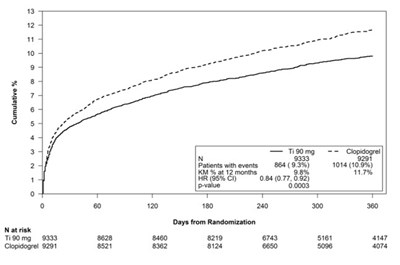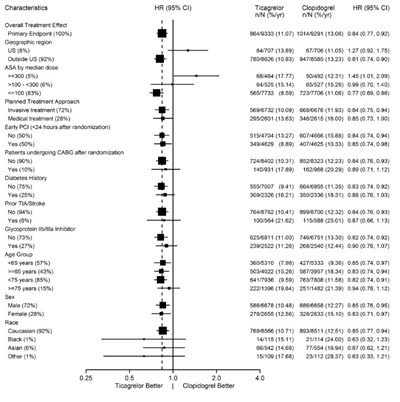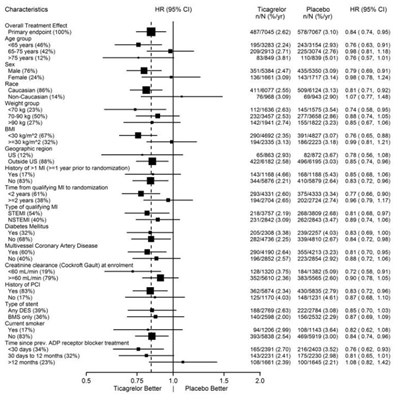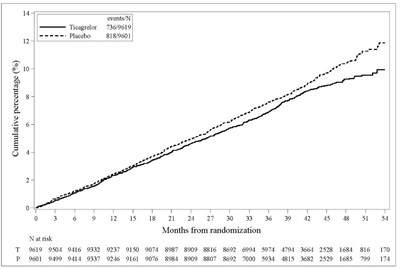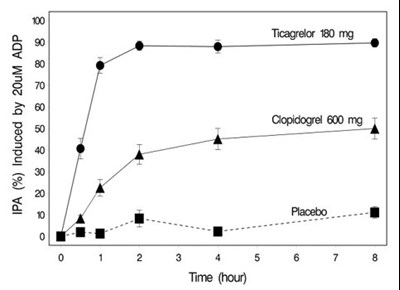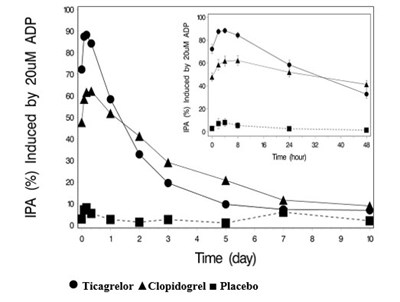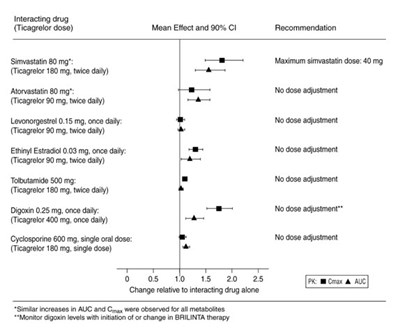Product Images Brilinta
View Photos of Packaging, Labels & Appearance
Product Label Images
The following 21 images provide visual information about the product associated with Brilinta NDC 0186-0777 by Astrazeneca Pharmaceuticals Lp, such as packaging, labeling, and the appearance of the drug itself. This resource could be helpful for medical professionals, pharmacists, and patients seeking to verify medication information and ensure they have the correct product.
60 mg label

BRILINTA is a prescription-only medication that comes in the form of ticagrelor tablets. The drug is packaged in a box containing 60 tablets and has an NDC code of 0186.0776.60. The packaging includes a medication guide, which should be dispensed to each patient. AstraZeneca is the company behind this medication. No information is available regarding the other words in the text, mostly composed of numbers and out-of-context words.*
90 mg label

This is a description for a prescription drug called BRILINTA, which comes in the form of tablets containing Ticagrelor. The package contains 60 tablets and it is available only with a prescription (Rx only). The text also indicates that a Medication Guide should be dispensed to each patient. The manufacturer of the drug is AstraZeneca.*
Figure 1
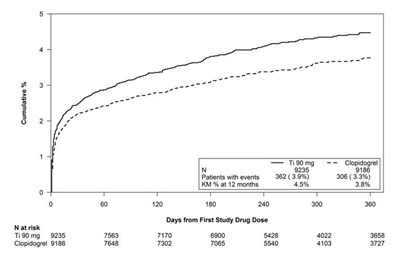
This appears to be a statistical comparison between clopidogrel and Tigomg for patients with events, measured at 12 months. The table shows the number of patients and the percentage of patients with events for both treatments. It also displays a Kaplan-Meier estimate at 12 months for both treatments. Additionally, there is a graph that shows the days from the first dosage of the study drug and the number of patients at risk over time for both treatment groups. No further context is provided.*
Figure 2

This text appears to be a graph regarding the percentage of patients who had an event after undergoing CABG. The graph displays the percentage range from 50% to 100%, with markers every ten percent. The axes are not labeled, but there appears to be data points plotted on the graph, presumably pertaining to individual patients or sample groups. The numbers under the graph may represent time intervals or data points regarding the patients' outcomes.*
figure 08

This text provides information related to drug interactions with Ticagrelor AR-C124910XX and the recommendations regarding the concomitant use of different drugs based on their effects on CYP3A4 enzymes. The text also includes recommended dose adjustments or avoidance for strong CYP3A4 inhibitors and potent CYP3A4 inducers. However, there is not enough information to generate a useful description.*
figure 12

This text appears to be a table displaying the results of ASADose for Ticagrelor and Clopidogrel. The table includes various dosages in mg (milligrams) and shows the percentage of patients who experienced HRE (high residual platelet reactivity) in response to each dosage. It is not possible to determine the specific recommendations or conclusions based on this information.*
figure 16

The text appears to be a table that outlines various characteristics of patients along with their Hazard Ratios (HR) for Ticagrelor and Placebo treatments. The parameters include characteristics such as age, sex, race, BMI, geographic region, aspirin dose, HbAle, eGFR, Insulin use, history of angina, multivessel coronary artery disease, history of PCI and CABG, smoking habits, and duration of diabetes. The HR represents the likelihood of the chosen characteristic increasing the chances of Ticagrelor treatment being more effective as compared to Placebo.*
figure 17

This appears to be a table showing the results of a clinical trial comparing the effectiveness of ticagrelor 90 mg bd vs placebo. The table shows the number of events (303/5523) and percentage (5.4%) of participants who experienced the outcome with ticagrelor compared to placebo (362/5493, 6.5%). There is also a graph displaying the number of participants at risk over time from randomization.*
figure 18

This text appears to be a statistical report or chart of a clinical study. It includes data on demographic characteristics of the study participants such as age, sex, race, weight, medical history, and other factors. It also includes numbers and percentages of participants who received different treatments and their corresponding outcomes, as well as hazard ratios with confidence intervals. Due to the technical nature of the text, it may not be readily understandable to those without a background in medicine or statistics.*
figure 3

This is a clinical trial report showing the results of a study involving the use of Ticagrelor, a medication commonly used to prevent blood clots following a heart attack or other coronary artery disease. The report compares Ticagrelor with a Placebo drug and shows the cumulative percentage of patients in each group who experienced certain outcomes, such as cardiovascular events. The data is presented over time, from 0 to 54 months, and includes the number of patients at risk during each time period.*
figure 4

This text represents a tabular format that displays the cumulative percentage, number of events, and KM percentage for two drugs "Ticagrelor 90 mgbd" and "Placebo" over a specific period of time. However, the table lacks appropriate labeling and complete data making it difficult to infer any relevant information from it.*
* The product label images have been analyzed using a combination of traditional computing and machine learning techniques. It should be noted that the descriptions provided may not be entirely accurate as they are experimental in nature. Use the information in this page at your own discretion and risk.

